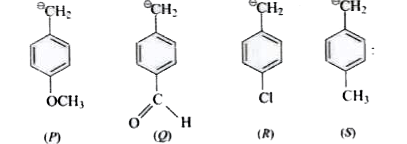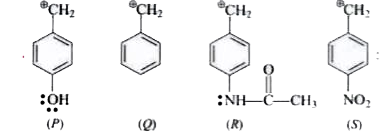The increasing order of stability of the following free radicals is
(CH3)2∗CH<(CH3)3∗C<(C6H5)2∗CH<(C6H5)3∗C
(C6H5)3∗C<(C6H5)2∗CH<(CH3)3∗C<(CH3)2∗CH
(C6H5)2∗CH<(C6H5)3∗C<(CH3)3∗C<(CH3)2∗CH
(CH3)2∗CH<(CH3)3∗C<(C6H5)3∗C<(C6H5)2∗CH
The correct Answer is:A
To determine the increasing order of stability of the given free radicals, we need to analyze the structure and the factors that contribute to the stability of free radicals. The stability of free radicals is influenced by resonance and the inductive effect of substituents attached to the carbon atom bearing the unpaired electron.
1. Identify the Free Radicals:
- Let's denote the free radicals as follows:
- Radical A: A carbon with two CH3 groups and one hydrogen.
- Radical B: A carbon with three CH3 groups.
- Radical C: A carbon with one hydrogen and two benzene rings.
- Radical D: A carbon with one hydrogen and one benzene ring.
2. Analyze Stability Factors:
- Inductive Effect: Alkyl groups (like CH3) are electron-donating through the inductive effect (+I effect), which stabilizes the free radical. The more alkyl groups attached, the more stable the radical.
- Resonance: Free radicals that can delocalize the unpaired electron through resonance are more stable. Benzene rings provide significant resonance stabilization.
3. Stability Comparison:
- Radical A: Has two CH3 groups providing +I effect, but no resonance.
- Radical B: Has three CH3 groups providing the highest +I effect, but again no resonance.
- Radical C: Has two benzene rings providing resonance stabilization, which is significant.
- Radical D: Has one benzene ring, providing some resonance stabilization, but less than Radical C.
4. Rank the Stability:
- Radical B (most stable due to three +I effects).
- Radical A (more stable than D due to two +I effects).
- Radical C (more stable than D due to resonance).
- Radical D (least stable due to only one benzene ring).
5. Final Order of Stability:
- The increasing order of stability is:
- Radical D < Radical C < Radical A < Radical B
- Let's denote the free radicals as follows:
- Radical A: A carbon with two CH3 groups and one hydrogen.
- Radical B: A carbon with three CH3 groups.
- Radical C: A carbon with one hydrogen and two benzene rings.
- Radical D: A carbon with one hydrogen and one benzene ring.
- Inductive Effect: Alkyl groups (like CH3) are electron-donating through the inductive effect (+I effect), which stabilizes the free radical. The more alkyl groups attached, the more stable the radical.
- Resonance: Free radicals that can delocalize the unpaired electron through resonance are more stable. Benzene rings provide significant resonance stabilization.
- Radical A: Has two CH3 groups providing +I effect, but no resonance.
- Radical B: Has three CH3 groups providing the highest +I effect, but again no resonance.
- Radical C: Has two benzene rings providing resonance stabilization, which is significant.
- Radical D: Has one benzene ring, providing some resonance stabilization, but less than Radical C.
- Radical B (most stable due to three +I effects).
- Radical A (more stable than D due to two +I effects).
- Radical C (more stable than D due to resonance).
- Radical D (least stable due to only one benzene ring).
- The increasing order of stability is:
- Radical D < Radical C < Radical A < Radical B
Topper's Solved these Questions
- BOOK - NCERT FINGERTPS ENGLISHCHAPTER - ORGANIC CHEMISTRY-SOME BASIC PRINCIPLES AND TECHNIQUES EXERCISE - Exemplar Problems12videos
ORGANIC CHEMISTRY-SOME BASIC PRINCIPLES AND TECHNIQUES
- BOOK - NCERT FINGERTPS ENGLISHCHAPTER - ORGANIC CHEMISTRY-SOME BASIC PRINCIPLES AND TECHNIQUES EXERCISE - Assertion & Reason13videos
ORGANIC CHEMISTRY-SOME BASIC PRINCIPLES AND TECHNIQUES
- BOOK - NCERT FINGERTPS ENGLISHCHAPTER - HYDROGEN EXERCISE - Assertion And Reason15videos
HYDROGEN
- BOOK - NCERT FINGERTPS ENGLISHCHAPTER - PRACTICE PAPER 1EXERCISE - Practice Paper 144videos
PRACTICE PAPER 1
Similar Questions
Knowledge Check
- Question 1 - Select One
Decreasing order of stability for the following radicals is :
 AII>III>I>IVBIII>II>I>IVCIII<II<IlVDI<IV<II<III
AII>III>I>IVBIII>II>I>IVCIII<II<IlVDI<IV<II<III - Question 2 - Select One
The decreasing order of stability of following anions is
 AS>R>Q>PBP>Q>R>SCQ>P>S>RDP>Q>S>R
AS>R>Q>PBP>Q>R>SCQ>P>S>RDP>Q>S>R - Question 3 - Select One
The decreasing order of stability of following anions is
 AQ>R>S>PBR>Q>P>SCS>P>R>QDP>Q>R>S
AQ>R>S>PBR>Q>P>SCS>P>R>QDP>Q>R>S
The decreasing order of stability of following anions is
 View Solution
View SolutionThe decreasing order of stability of following anions is
 View Solution
View SolutionThe decreasing order of stability of following anions is
 View Solution
View SolutionThe decreasing order of stability of following cations is
 View Solution
View SolutionThe decreasing order of stability of following cations is
 View Solution
View Solution


